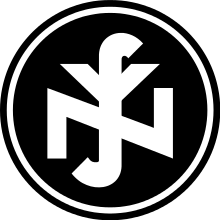National Socialist People's Welfare

The National Socialist People's Welfare (NSV) was founded by the National Socialists on April 18, 1932 as a registered association and on May 3, 1933, just a few months after the seizure of power , elevated to the status of a party organization of the NSDAP . Its director was Erich Hilgenfeldt . The headquarters were in Berlin-Wilmersdorf , the building complex of which was designed by the architect Hugo Constantin Bartels .
Organization and history
Initially, welfare work within the party barely had a lobby, which is why no welfare organization, as with other parties, was founded. Over time, however, it became apparent that charitable services were "well received" by the population and that they could be exploited for the party's own propaganda. In response to this, the NSV was founded in Berlin in September 1931 as a local self-help association. The NSV, which initially operated regionally, was able to post good successes in the period that followed, which, however, also earned resentment in the ranks of the NSDAP. For example, at the end of 1932 she was forbidden to call herself National Socialist. However, this ban did not last long and was reversed a short time later.
In the course of harmonization with the prohibition of workers' welfare , the NSV joined the seven remaining welfare organizations as a state organization and association .
Although the NSV did not succeed in monopolizing all free welfare despite the prohibition of workers' welfare, leading associations such as the German Red Cross (DRK), the Protestant Diakonie or the Catholic Caritas were originally pushed back.
The structure resembled the structure of the NSDAP with local, district and group administrations. It was divided into six “offices”: organization, financial management, welfare and youth welfare, public health, propaganda and training. The NSV received its guidelines from the “Main Office for People's Welfare” , subordinate to the district leader . In mid-1939 the NSV consisted of 40 district administrations, 813 district administrations, 26138 local administrations, 97,161 cells and 511,689 blocks.
From 1933 the NSV was the publisher of the monthly National Socialist People's Service and from 1936 of the book series Ewiges Deutschland .
As long as there was still mass unemployment , the NSV also helped families in need financially, after which (around 1938) it shifted to pure services. In this context, the NSV ran kindergartens that competed with comparable church institutions. Party members took their children to the new NSV kindergartens with their Hitler cult motto: "Fold your hands, lower your head - always think of the Führer. He gives you your daily bread and saves you from every need. "
The association was financed by donations and the contributions of its paying members. At the end of 1938 there were about a million volunteer workers in the NSV. At the beginning of the war, the NSV had eleven million members.
In the course of the Second World War , the NSV took on more and more (actually state) tasks, especially in the field of child and youth work. From 1940 she also organized the Kinderlandverschickung for children under ten years of age. One of the better known NSV relief organizations was called " Mother and Child ". This cared for the "Aryan" women during the entire pregnancy as well as after the birth of the child. Mothers continued to receive financial support in emergencies. The care was continued in the kindergartens and maternity homes of the NSV. From mass shootings in Babyn Yar and Zhytomyr in 1941, the NSV were handed 137 trucks with clothes of those who had been shot, most of which were sent to ethnic Germans after being disinfected .
With the Control Council Act No. 2 of October 10, 1945, the organization was banned by the Allied Control Council and its property was confiscated.
Aid organizations and services
The following relief organizations and institutions were subordinate to the NSV:
- Adolf Hitler free space donation
- Station service
- Food aid organization
- Community care stations
- Home help
- Aid organization for the German visual arts
- Aid organization mother and child
- Youth welfare
- kindergarten
- Kinderland delivery
- motorized dental stations
- Mothers' service in the German Women's Association
- Reichsverband Deutscher Jugendheimstätten e. V.
- Tuberculosis Relief Organization
- Winter Relief Organization
literature
- Eckhard Hansen: Welfare policy in the Nazi state: motivations, conflicts and power structures in the "socialism of action" of the Third Reich . Maro Verlag, Augsburg 1991, ISBN 3-87512-176-7 .
- Oliver Kersten: The National Socialist People's Welfare, especially in the Second World War. Master's thesis at the Friedrich Meinecke Institute of the Free University of Berlin 1993, 160 sheets. Locations: SAPMO Federal Archives Library Berlin and Friedrich Meinecke Institute of the Free University Berlin
- Herwart Vorländer: The NSV. Representation and documentation of a National Socialist organization. Harald Boldt Verlag, Boppard am Rhein 1988, ISBN 3-7646-1874-4 ( Writings of the Federal Archives , 35).
Web links
Individual evidence
- ↑ Monument formerly Volkswohlfahrt in Sächsische Strasse
- ↑ Stephanie Merkenich: The German Red Cross under the Nazi dictatorship 1933-1945 . Schöningh, Paderborn 2008, ISBN 978-3-506-76529-1 , p. 8 .
- ^ Marie-Luise Recker: Encyclopedia of National Socialism . Ed .: Wolfgang Benz , Hermann Graml, Hermann Weiss. Deutscher Taschenbuch Verlag, Munich 1997, ISBN 3-423-33007-4 , pp. 678-679 .
- ↑ Eckhard Hansen: Welfare Policy in the Nazi State: Motivations, Conflicts and Power Structures in “Socialism of Action” of the Third Reich . Maro Verlag, Augsburg 1991, ISBN 3-87512-176-7 , p. 8 .
- ↑ Babi Yar in Ukraine - A ravine as a mass grave . ( Memento of June 5, 2013 in the Internet Archive ) ITS - International Tracing Service; accessed January 17, 2015



